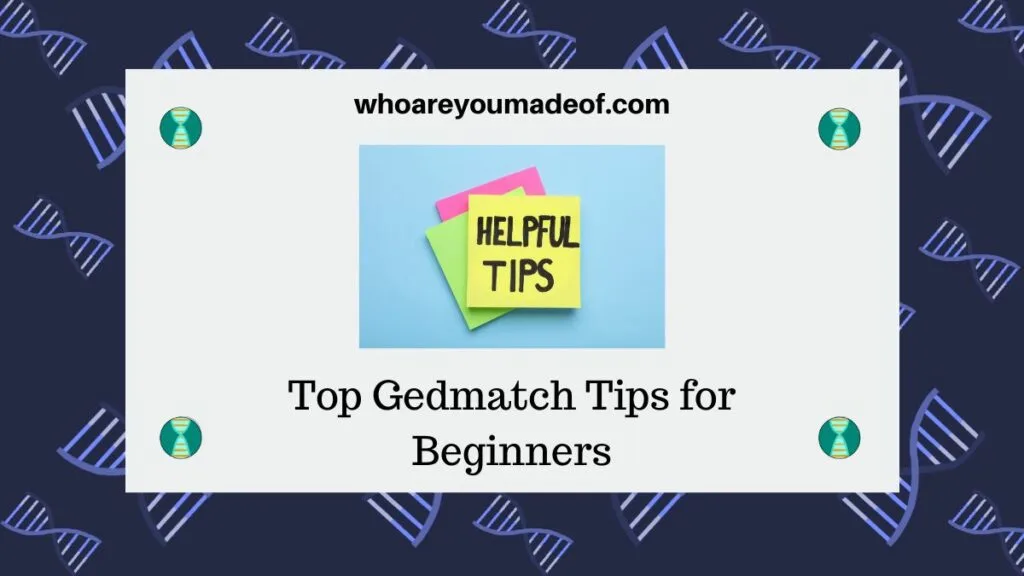If you have uploaded your DNA to Gedmatch, you might feel overwhelmed and confused with all of the different tools available. Here, find beginner tips for getting started on Gedmatch.

You will learn the best way to use Gedmatch, even if you are brand-new to the site. It is an amazing website, and you will be able to use it with a little bit of practice.
Start with the One-to-Many comparison tool
This is by far the most popular tool on the site, and it is usually the one that most people are interested in using when they first get started on the site. The One-to-Many tool is how you find relatives on Gedmatch.
After you have done your upload to Gedmatch, it usually takes between several hours to a few days for your kit to finish batch processing.
Once it does, you'll be able to view your One-to-Many results, which is exactly where I recommend beginning your fantastic Gedmatch adventure. It is the most self-explanatory place to begin for those who are learning how to use Gedmatch.
The Gedmatch One-to-Many tool compares your DNA kit with all of the other DNA kits on the site, and presents you with a (very, very) long list of people who are potentially related to you. These are your DNA matches on Gedmatch.
Some of the DNA matches on your list will have tested their DNA with the same company that you chose. However, you are very likely to find genetic relatives on Gedmatch that tested their DNA with other companies.
For example, if you tested your DNA with AncestryDNA, you could upload your DNA to Gedmatch to find DNA matches that tested with 23andMe. The only action that a person who has tested their DNA to find other matches needs to make is upload their DNA to Gedmatch.
The One-to-Many application does the rest of the work for us.
The default style of this list shows people who share the most DNA with you at the top, with the people who share less DNA with you further down the list. The people at the top of the list are very likely to be relatives and are among your closest relatives on the site.
One of the benefits of Gedmatch is that they accept DNA file uploads from several different DNA testing companies, which means that you might find DNA relatives on this site that aren't on your DNA match list that you received from your testing company.
For more information on this tool, read my post: How to understand Gedmatch One-to-Many results
Don't forget to do a One-to-One comparison with individual matches
Did you spot a match on your One-to-Many list that needs further investigation? Maybe it's a match with a surname that you have in your family tree, or maybe it's someone with whom you seem to share a good bit of DNA.
No matter the reason, you should always compare your DNA with your match's DNA using the One-to-One tool.
The One-to-One tool can provide you with more detailed information about your potential match with this person, as well as confirm that you are indeed a match (most useful with distant matches).
On your One-to-One comparison results, you will see your DNA compared with the DNA match on a chromosome-by-chromosome level. You'll get to see how many DNA segments you share, the size of the segments, and the exact location of those segments - all great information when trying to figure out how you are related to someone.
Learn more about what you can learn from the One-to-One comparison tool in my post about how to understand the One-to-One results.
How to know how you are related to a match on Gedmatch?
I hope that you've read my post on understanding One-to-Many and One-to-One results, which I linked to in the paragraphs above. If you have, you might have already noticed that there are limits to how much you can learn from only knowing the amount of shared DNA that you have with your match.
Eventually, it becomes necessary to use more traditional means to work out your exact relationship.
In other words, total cMs, which is short for centimorgans that are used to measure the amount of DNA shared between two people, can give you an idea of how you are related. To find out exactly how you are related, you will need more information.
Since this is a "top tip" post, I'll briefly list some tricks to help you learn more about your DNA match:
- From your One-to-Many results page, you can see if your DNA match has a family tree. If they do, there will be a "GED" or "Wiki" link next to their kit number. Unfortunately, most people don't upload their trees to Gedmatch, which is why I recommend that everyone do so (read about how to upload your tree to Gedmatch)
- The beginning letter of your DNA match's kit number can tell you where they tested. For example, people whose kits start with a "T" tested with Family Tree DNA, and people who have an "A" at the beginning of their kit number tested with Ancestry. If you have also tested with the same company, or have uploaded your DNA to that site, you might be able to find them on your DNA match list on those sites. Potentially, they have listed more information, or even included a family tree on their profile.
- After you've learned as much as you can, you might consider reaching out to your match to see if they would like to be in touch with you to share family history information.
Additional tips on this topic:
- You can use the People Who Match One or Both of Two Kits tool to see if you have matches in common who have family trees on the site. While this doesn't guarantee that you and your match are both related to the match in common in the same way, it can provide valuable information.
- Read my post "How to figure out how a DNA match is related: a checklist"
What are Gedmatch Admixture calculators?
For some people, the Gedmatch Admixture calculators are the main attraction of the site. For others, it is a little known feature.
First, what in the world is "admixture"? It's just a fancy word that geneticists use to describe mixing of people with different genetic backgrounds. If someone who is a German has children with someone who is from Spain, their children will likely have admixture from both regions, such as Germanic and Iberian ethnicity.
Most people, even those whose families have lived in the same part of the world for generations, have at least some degree of admixture. Some regions of the world, such as parts of Europe, tend to be very admixed. Other groups of people, like Native Americans, generally show less admixture.
DNA testing companies don't usually use the word Admixture in their marketing materials - it is a confusing word. Instead, they call admixture results "ethnicity estimates" or "ancestry composition" reports or "myOrigins" estimates.
No matter what they are called, however, they are the subject of a lot of interest and discussion.
In fact, some individual scientists and researchers are so interested in this topic that they have begun their own research projects using collected DNA data and have developed their algorithms for providing ethnicity estimates. Many of the these independent projects have been made available on Gedmatch and they can be found in the Gedmatch Admixture calculator section.
Most of the calculators tend to focus on a specific population. Some are great for people of primarily African descent, while others are more useful for people who have primarily European ancestry.
Just play around with them a little bit and see if you find out something interesting about your DNA.

Conclusion
I hope that you have enjoyed this post, and that it has helped give you the basic information to get started on the site. If you have any questions about osmething that you read in this post, please let me know in the discussion.
Thanks for stopping by!

